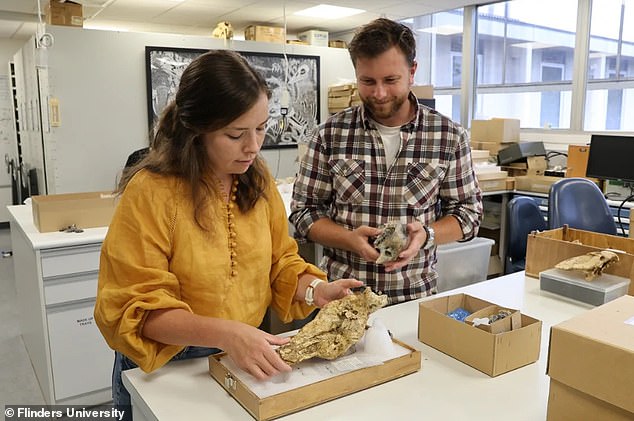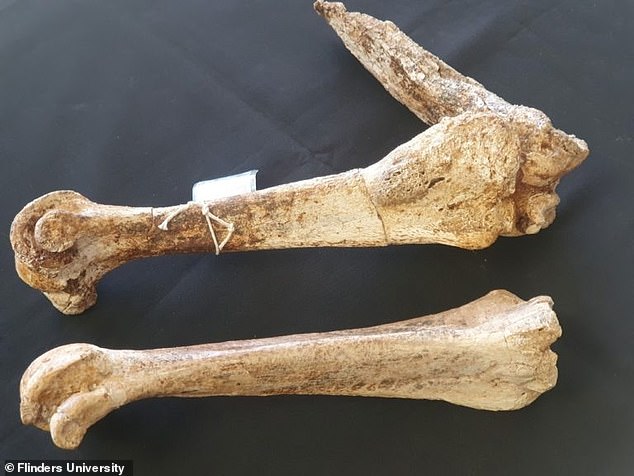Stunned researchers discover rare skull of 230kg 'giant goose' that went extinct 50,000 years ago - allowing them to finally reveal what the animal looks like
- Scientists say unearthed skull finally reveals what the species looked like
- READ MORE: Humans wiped out ancient Australian dodo-like bird
It roamed Australia's murky swamps until around 50,000 years ago.
But scientists never quite knew what the ancient 'mega-bird' Genyornis newtoni looked like.
Now, that's all changed, as experts have uncovered the most complete skull of the species ever to be found.
Measuring 6.5 feet (two metres) tall and weighing up to 230 kilograms, new artistic depictions show it was like a 'giant goose' with tiny wings and massive hind legs.
The dodo-like bird, closely related to early waterfowl, is thought to have been wiped out by early humans in Australia who feasted on its melon-sized eggs.

The giant skull of the ancient Australian bird called Genyornis newtoni, pictured) reveals it was a prehistoric ‘giga-goose’

The illustration portrays a reconstruction of Genyornis newtoni at the water’s edge in a wetland or swamp-like environment
Another recent study suggests it was affected by bone disease before its extinction around 50,000 years ago.
Stunned researchers managed to excavate its newly-found giant skull from the saline, dry beds of Lake Callabonna, a remote region of inland South Australia.
One of the discoverers, Dr Phoebe McInerney at Flinders University in Adelaide, said the species was like a 'giant goose'.
'Genyornis newtoni had a tall and mobile upper jaw like that of a parrot but shaped like a goose,' Dr McInerney said.
'[It had] a wide gape, strong bite force, and the ability to crush soft plants and fruit on the roof of their mouth.'
Highly flexible joints in the skull allowed it to open its mouth wide, like parrots can, while powerful muscles attaching to the back of the skull allowed a strong backwards pull of the head.

This image shows how Genyornis newtoni (depicted far right) is related to modern landfowl and waterfowl

Researchers excavated its newly-found giant skull from the saline, dry beds of Lake Callabonna, a remote region of inland South Australia

Artistic 3D rendering of the Genyornis newtoni skull. The species Measured 6.5 feet (two metres) tall and weighed up to 230 kilograms
Genyornis newtoni was the last of the large, flightless mihirungs ('thunder birds') endemic to Australia.
The only previously known skull for this species, reported in 1913, was heavily damaged and had little of the original bone remaining, so not much could be deduced about the skull of this species.
But with this new fossil – which joins nearly complete fossils of the rest of the body – researchers can reveal what this species really looked like.
As well as clues from the bones, scientists have interpreted its appearance based on large, flightless relatives, such as Dromornis and the more distantly related emus.
Genyornis newtoni had adaptations for immersing the head in water, including nostrils far back by the eyes and isolation of the ear from the regions involved in jaw movement.
This features helped prevent water inflow and limit hearing interference while feeding submerged, although its diet is thought to have been largely plant-based.
'Genyornis was adapted to thrive around swamps, wetlands and lakes,' the researchers say in a joint statement published in The Conversation.
'Today, the large bodies of freshwater once present in northern South Australia are mostly dry salt lakes.

Phoebe McInerney and Jacob Blokland with a skull of Genyornis newtoni in Flinders University's palaeontology lab

The species may have been affected by bone disease before its extinction around 45,000 years ago, a prior study found
'[The species'] partial reliance on freshwater and new plant growth would have become more difficult as ponds and lakes shrunk and disappeared.'
The team conclude that the drying of the Australian continent likely contributed to the eventual extinction of Genyornis, but other researchers have laid the blame squarely at humans.
Although Australia suffered continental drying from about 60,000 to 40,000 years ago, it likely wasn't strong enough to wipe out the megafauna, a prior study by experts in the US claimed.
Fragments of burnt egg shells from historic human camp fire sites suggest humans were collecting and cooking the eggs, causing numbers to plummet.
The newly-found skull has been detailed further in a study published in Historical Biology.































































































































































































